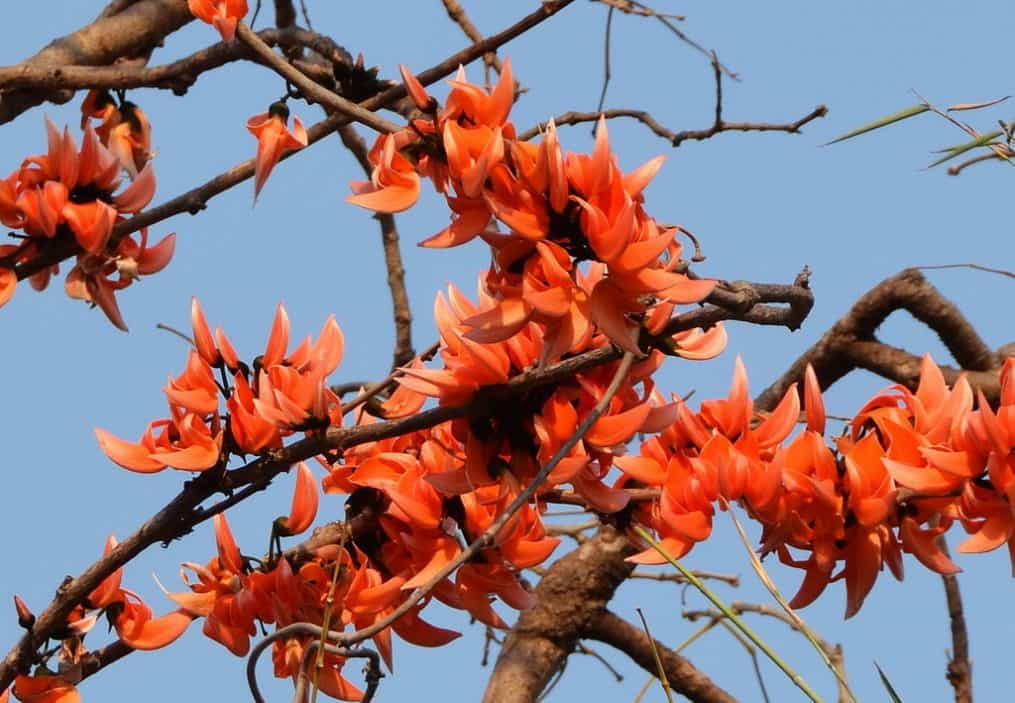A Review on Butea monosperma (Lam.) kuntze: A Great Therapeutic Valuable Leguminous Plant
Butea monosperma (Lam.)
Divya fageria, Dr. D.V. Rao
Biotechnology lab, lab no.5 , Department of Botany , University of Rajasthan, Jaipur
Abstract
Butea monosperma (Lam.) kuntze [Family: leguminosae] is a medium-sized deciduous tree popularly known as Flame of forest, Dhak or palas in Hindi, Bastard Teak in English, Parasa in Tamil which is widely distributed throughout India, Burma and Ceylon The family fabaceae compromises of 630 genera and 18000 species. It is adaptable tree for sub-tropical regions which requires alkaline, swampy badly drained soils and a sunny location. It grows easily from seed. It finds use both medicinally and commercially with each part of the plant having utility. Extract of the plant possess significant astringent , aphrodiasiac, anti-helmintic, anti-inflammatory anti- bacterial , anti-fungal , anti-diabetic and anti -asthmatic properties. This article briefly reviews the botany, distribution, ecology, uses of the plant, chemical composition , pharmacological activites of the plant and its constituents .This is an attempt to compile and document information on different aspect of Butea monosperma (Lam) Kuntze and its potential uses.
Index Terms Butea monosperma (Lam.) kuntze, Dhak, Palas, Flame of forest, Astringent, Aphrodiasiac, Anti-asthmatic, Anti-helmintic, Chemical composition.
Introduction
From the time immemorial, plants have been widely used as curative agents for variety of ailments. Concentrated flowers or seeds extract can be found in various herbal preparations which are widely available in market today .Herbs have always been the principal form of medicine in India and presently they are becoming popular throught the world, as people strive to stay healthy in the face of chronic stress and pollution, and to treat illness with medicines that work in count with the body’s own defence .There is a widespread belief that green medicines are healthier and more harmless or safer than synthetic ones. In traditional medicine , there are many natural crude drugs that have the potential to treat many disease and disorders . Butea monosperma (palas) is a medium -sized deciduous tree belongs to family fabaceae and sub- family papilionaceae. This tree is also called ‘Flame of the Forest’ and Bastard Teak ( Kirtikar and Basu, 1935) .They comprise one of the largest families of flowering plants numbering 630 genera and 18000 species (The wealth of India, 1988) . It grows throught the Indian subcontinent especially in Indo-Gangetic Plains (Chopra et al., 1958). It is said that the tree is a form of Agnidev,’God of Fire’. This tree grows up to 50 ft high ,with clusters of flowers. Flowers are offered in place of blood in sacrifice rituals to goddess Kali (Ambasta, 1994). The genus Butea includes Butea monosperma, Butea parviflora.Butea minor and Butea superba widely distributed thorough India. It is one of the most beautiful tree has been put to some useful purpose. All parts of plant have been used as crude drug for the treatment of tumors, piles, skin diseases, wounds and ulcers (Mengi and Deshpande,1995). Butea monosperma is extensibly used in Ayurveda , Unani and Homeopathic medicine and has become a treasure of modern medicine.The plants of this genus are well known for their colouring matters.Commonly Butea monosperma is used as tonic, astringent ,aphrodisiac and diuretics .(Nadkarni ,2002). The flowers are widely used in treatment of hepatic disorder, viral hepatitis, diarrhea ,depurative and tonic.The flowers are also good source of flavonoids. The contents of flowers are Butein, Butrin, Isobutrin ,Plastron ,coreipsin and isocoreipsin .Isolation of mediacarpin with antifungal activity from this part of plant has also been reported .The Euphane triterpenoid 3a-hydroxyeuph-25-ene and the alcohal 2,14-dihydroxy-11,12-dimethyl-8-oxo-octadec-11-enylcyclohexane has also been isolated from the stem (Mishra et al., 2000).The Imide palasimide has been isolated from the pods of this plant species. Studies on anti-oxidant status following ulceration indicate that free radicals seem to be associated with the pylorus ligation and ethanol induced ulceration in rats .The traditional system of medicine claims that the plant is a rejuvenator. Owing to its versatile characteristics, this plant is a multipurpose tree with immense medicinal and economical value.
A. Botanical Classification
Kingdom : Plantae
Division : Magnoliophyta
Class : Magnoliopsida
Order : Fabales
Family : Fabaceae
Genus : Butea
Species : monosperma
B. Botanical Name
Butea monosperma ( Lam.) kuntze
C. Common Names
According to Kirtikar and Basu (1935) all the common names of this plant are listed
Sanskrit : Palasah
Hindi : Dhak, Palas, Chalcha
English : Bastard Teak, Parrot Tree
Bengali : Palas, Polashi
Marathi : Kakracha
Gujarati : Khakharo
Tamil : Parasa
Documented Species Distribution
A. Native
Tropical South Asia, especially from the region of Pakistan, India (Indo-Gangetic plains), Vietnam, Malaysia, Western Indonesia, Laos , Cambodia , Bangladesh, Nepal, Sri-Lanka, Manmar, Thailand.
B. Occurrence
It is common throught out the greater part of India ,Burma and Ceylon extending in the north west Himalayas up to 1000 m, and higher in the outer Himalaya , Khandesh Akrani up to 1200m and Hill of South India up to 1300 m.(Chopra,1991). It is especially found in Maharashtra (Kolhapur) Karnataka (chikmagalur, coorg, mysore, Shimoga, S.Kanara )Kerala: Alapuzha, idukki, kasaragod, kollam, Kozhikode, malapuram. palakkad. Rajasthan : Jaipur ,Udaipur, kota in throughtout india, except jammu&Kashmir, Himachal Pradesh, Sikkam, Arunachal Pradesh, Assam, Nagaland, Meghalaya, Manipur,Tripur, Mizoram.
C. Butea species
The plant belongs to family fabaceae which is widely distributed in throughout the world. Below mentioned species were recorded. Butea acuminate, Butea affinis, Butea Africana, Butea apoensis, Butea balansae, Butea braamiana, Butea bracteolate, Butea cuneiforms, Butea crassfolia, Butea dubia, Butea ferruginous, Butea gyrocarpa, Butea harmandii, Butea laotica , Butea listeria,Butea littoralis,Butea loureirii, Butea parviflora, Butea pulchra, Butea purpuea, Butea minor, Butea macroptera, Butea maingayi, Butea merguensis, Butea rosea, Butea riparia, Butea suberecta , Butea superba , Butea oblong folia ,Butea varians, Butea volubilis.
Ecology
Native to sub tropical environments, It is capable of growing in waterlogged situation, black cotton soil, saline, alkaline, swamy badly drained soils and on barren landa except in arid region.This species grows to elevations of 1200m.It regenerates naturally and easily in mixed deciduous stands in temperate forests.Natural reproduction is profuse by seed
Mythological History
It is believed that the tree is a form of agnidev ,God of fire.It was a punishment given to him by Goddess parvati for disturbing her and lord shiva’s privacy(Murti et al., 1940).
Botanical Description
Butea monosperma is a erect medium sized dry season-deciduous tree,growing to 15m tall.All the botanical descriptive characters of this plant are listed in Table 1.
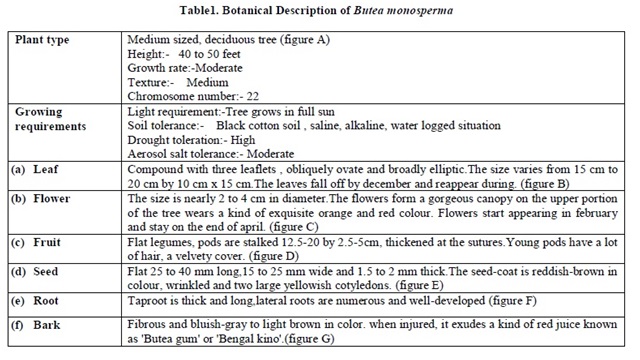
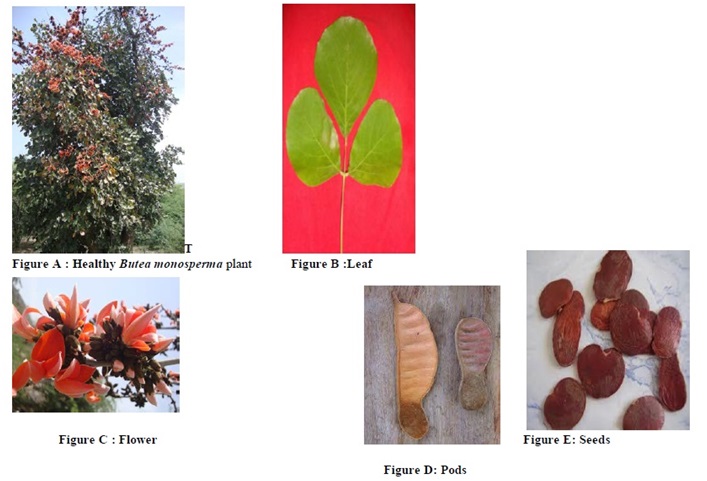
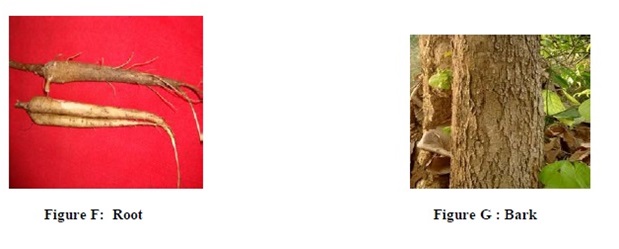
Growth Pattern
Growth is seen best from sea level to an altitude of 1200m and optimal rainfall of 500 to 2500mm.It sheds its leaves in Dec. and develops new leaves from March onwards. Flowers appear in february to end of the April (Cowen, 1984) . Seed ripens from February to May as shown in Table2 .
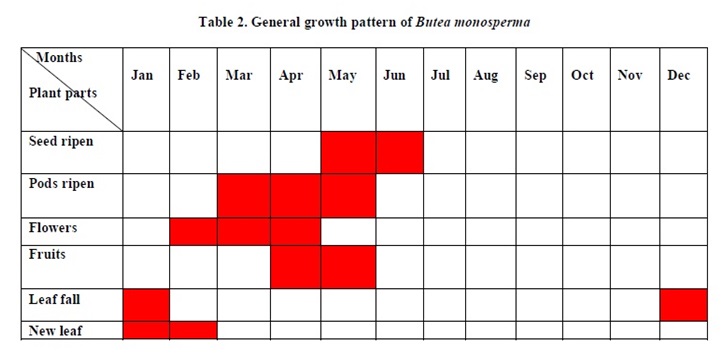
NUTRITIVEEVALUATION
Leaf extract of Butea monosperma contain nutritive value (Ramana et al., 2000) as shown in Table.
OM – 889.2
CP – 150.2
NDF – 506.1
ADF – 356.0
Cellulose – 151.2
Hemicellulose – 150.2
Lignin – 130.7
Total phenolics – 6.5
Condensed Tannins- 20.8
OM =Organic matter ADF=Acid detergent fibre
CP = Crude protein NDF=Neutral detergent fibre
Chemical Constituents
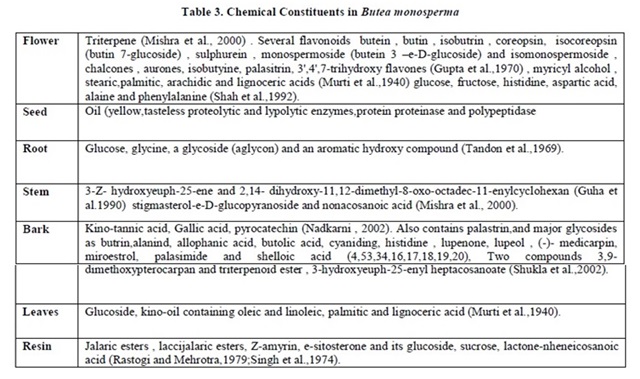
Economical and Medicinal Value
The plant Butea monosperma has immense medicinal and economical values which are tabulated in Table 4.
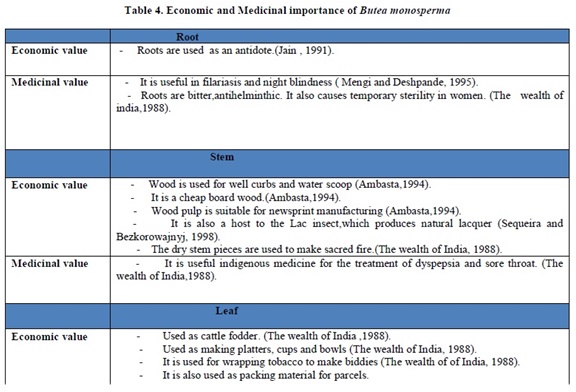
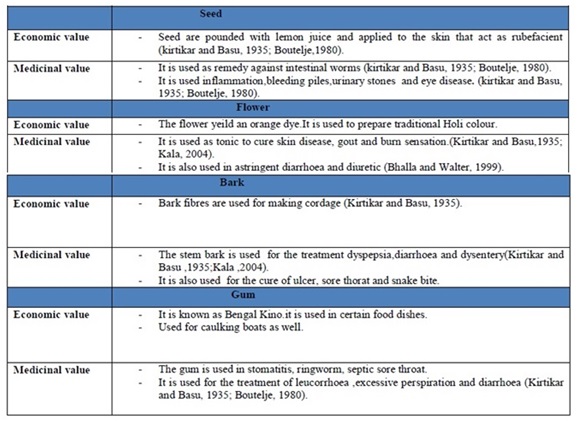
Pharmacological Activities
A. Antifungal activity, Antimicrobial activity and Antibacterial activity
The stem bark of Butea monosperma displays antifungal activity which is due to the presence of an active constituent (-)-medicarpin (Bandara et al.).The seed oil of Butea monosperma shows significant bactericidal and fungicidal effect in in-vitro testing (Mehta and Bokadia, 1981).
B. Anti-inflammatory activity
The leaves of Butea monosperma exhibit ocular anti-inflammatory activity in rabbits (Mengi and Deshpande , 1995).The anti-inflammatory activity of methanolic extract of Butea monosperma evaluated by carrageenan induced paw edema at 600 and 800 mg/kg inhibition of paw edema by 26 and 35% in cotton pellet granuloma inhibition of granuloma tissue formation by 22 and 28% (Shahavi and Desai, 2008).
C. Anticonvulsive activity
It shows anticonvulsive activity due to the presence of a triterpene. (Kasture et al.,2002).The ethanolic extracts of leaves of Albizzia lebbeck and flowers of Hibiscus rosa sinensis and the petroleum ether extract of flowers of Butea monosperma exhibited anticonvulsant activity.The acetone soluble part of petroleum ether extract of Butea monosperma flowers showed anticonvulsant activity.The fractions protected animals from maximum electroshock electrical kindling pentylenetetrazole and lithium-pilocarpine induced convulsion but failed to protect animals from strychnine-induced convulsions.The fractions raised brain contents of gamma-aminobutyric acid (GABA) and serotonin (Kasture et al., 2000).
D. Anti-esterogenic and anti-fertility activity
Alcoholic extract of flowers of Butea monosperma has also been reported to exhibit antiestrogenic (Shah et al., 1990). Hot alcoholic extract of Butea monosperma seeds have been reported for significant anti ovulatory and anti-implantation activities
when given to rats and rabbits.The active constituent has been identified as butin (Bhargava , 1986). Butin also exhibits male contraceptive properties (Dixit et al., 1981). Antifertility effect of seed extract of Butea frondosa has also been reported in mice (Razdan et al., 1970). The stem bark of Butea monosperma led to the isolation and identification of three new compounds named buteaspermin A, buteaspermin B and buteaspermanol along with 19 known compounds (Maurya et al., 2009).
E. Anti-diabetic activity
The single dose treatment of ethanolic extract of Butea monosperma flowers at the dose of 200mg/kg P.O significantly improved glucose tolerance and cause reduction in blood glucose level in alloxan induced diabetic rats.(Somani et al., 2006). Oral adminstration of the ethanolic extract of the Butea monosperma seeds at the dose of 300mg/kg b.w.,exhibited significant antidiabetic,hypolipaemic and antiperoxidative effects in non-insulin dependent diabetes mellitus rats.
F. Anti-diarrhoel activity
Butea monosperma gum has also been found useful in cases of chronic diarrhoea.It is a powerful astringent and also decrease bilirubin level.(Ramana et al., 2000).The ethanolic extract of stem bark of Butea monosperma at 400 mg/kg and 800 mg/kg inhibited castor oil induced diarrhoea due to inhibiting gastro-intestinal motility and PGE2 induced enteropooling.It is used as nonspecific anti diarrhoel agent in folk medicine .(Gunakkunru et al, .2005).
G. Free radical scavenging
Free radical scavenging activity of various extracts of flowers evaluated by using different in- vitro models like reducing power assay, scavenging of 2,2 diphenyl-1-picrylhydrazyl (DPPH) radical, nitric oxide radical, superoxide anion radical, hydroxyl radical and inhibition of erthrocytes hemolysis using 2,2′ azo-bis (amid inopropane) dihydrochloride (AAPH). Methanolic extract along with its ethyl acetate and butanol fractions showed potent free radical scavenging activity.The observed activity could be due to higher phenolic contents in the extract (Schoeller et al., 1938).
Anti helmintic activity
The seeds of the plant are used in Ayurvedic system as an anthelmintic drug. (Katti and Manjunath , 1929) .The crude powder of Butea monosperma seeds (CP) showed a dose-dependent (1-3 g/kg) and a time – dependent anthelmintic activity in sheep.The anthelmintic activity of different species of Butea has been reported against Ascaridia galli, Ascaris lumbricoides, earthworms, Toxocara canis, oxyurids, Dipylidium caninum and taenia (Iqbal et al., 2006).
I. Wound healing activity
The topical administration of an alcoholic bark extract of Butea monosperma on cutaneous wound healing in rats.Full-thickness excision wound were made on the back of rat.The granulation tissue formed on days 4,8,12 and 16 (post wound) was used to estimate total collagen hexosamine protein .DNA and uronic acid. The extract increased cellular proliferation and collagen synthesis at the wound site as evidenced by increase in DNA, total protein and total collagen content of granulation tissues The extract treated wounds heal much faster than normal animals as indicated by improved rates of epithelialization and wound contraction ,tensile strength and histopathological examinations Butea monosperma exhibited wound healing activities due to its antioxidant properties (Sumitra et al., 2005).
J. Thyroid in hibitory,Antiperoxidative and hypoglycemic effects
Stigmasterol isolated from the bark of butea monosperma was evaluated for thyroid hormone and glucose regulatory efficacy in mice the administration at 2.6 mg/kg/d for 20 days reduced serum triiodothyronine (T3), thyroxine (T4) and glucose concentrations as well as the activity of hepatic glucose-6-phosphatase (G-6-Pase) with a increase in insulin. Showed its thyroid inhibiting and hypoglycemic properties.Antioxidative potential due to decrese in the hepatic lipid peroxidation (LPO) and an increase in the activities of catalase (CAT), superoxide dismutase (SOD) and glutathione (GSH).The highest concentration tested (5.2mg/kg) evoked pro-oxidative activity (Panda et al., 2009).
K. Liver disorders
An extract from the flowers of Butea monosperma is used in India for the treatment of liver disorders and two antihepatotoxic flavonoids, isobutrin and butrin have been isolated from the extract. (Wagner et al., 1986). The effect of pretreatment of methanolic Butea monosperma extract prior to TAA treatment at two doses and the results suggest that it may contribute to the chemo preventive effect.Butea monosperma showed a significant recovery in the level of glutathione and its metabolizing enzyme in the liver induced the detoxifying enzyme system,which is shown by the elevated levels of other QR, SOD and xanthine oxidase which are important second phase enzyme. (Sehrawat et al. 2006).
L. Giardiasis
Giardiasis is a common gastrointestinal infection caused by a protozoal parasite, Giurdia lambia. Pippali rasayana(PR). An Ayurvedic herbal medicine prepared from piper longum (Pippali) and Butea monosperma (Palash) in which ash of stem,root,flower and leaves of Butea monosperma is used has significant activity against Giardiasis it produced up to 98%recovery from the infection.The rasayana had no killing effect on the parasite in vitro.It induced significant activation of macrophages as evidenced by increased macrophages migration index (MMI) and phagocytic activity with higher doses of PR recovery increased up to 98% at 900mg/kg. (Agarwal et al., 1994). Flowers of this plant are also effective in leprosy, leucorrhoea and gout (The wealth of india,1988).
Conclusion
Today it is a challenge for scientists to provide efficient, safe and cheap medications. In this scenario Butea monosperma can be an exclusive medicine which is widely available through our country. The present paper enumerates various pharmacognostic and pharmacological aspects of the plant. This review also summaries the therapeutic potential of this plant. The plant is used highly by the rural and tribal people in curing various disorders Butea monosperma has an effective natural origin that has a tremendous future for research. It is very essentials to have a proper documentation of medicinal plants and to know their potential for the improvement of health and hygiene through an ecofriendly system. The present review describes various traditional and medicinal utility of the plant and an attempt was made to gather information about the chemical composition and pharmacogical activity of the plant and its constituents.
References
A.K., Singh,M., Gupta, N., Saxena, R., Puri, A., Verma A.K., Saxena, R.P.,
Dubey C.B. and Saxena K.C. Management of giardiasis by an immuno-modulatory herbal drug Pippali rasayana, J of Ethnopharmacology, 44 (1994) 143-146
Ambasta, B.P., The useful plants of India, 1994,1-91, CSIR, New Delhi.
Bandara, B. M. R., Kumar, N. S., Wimalasiri, K.M.S. Journal of the
National Science Council of Sri Lanka 18, Agarwal 97- 103,
Barua, A. K., Chakrabarti, P. I., Das, K.G., Nair, M.S. B. Chemistry & Industry (London, U. K.) 1970,1376.
Bavarva, J.H. and Narasimhacharya, A.V.R.L. Preliminary study on antihyperglycemic and antihyperlipaemic effects of Butea monosperma in NIDDM rats. Fitoterapia 79 ,2008, 328–331.
Bhalla, V., Walter, H. Research Bulletin of the Punjab University, Science 48, 1999,87-94.
Bhargava,S.K., Estrogenic and postcoital anti conceptive in Rats of butin
isolated from Butea monosperma, J of Ethnopharmacology,18,1986,95-101.
Bishnoi, P., Gupta, P.C. Planta Medica 35, 286-288, 1979,286-288.
Boutelje JB.Encyclopedia of world timbers,names and technical literature(Ency WTimber)54,1980.
Chandra , S., LaI, J., Sabir. M. Indian Journal of Pharmacy, 39, , 1977,79-80
Chatterjea, J. N., Sengupta, S.C., Misra, G. S., Agarwal, S. C. Indian Journal of Chemistry, Section B 14B, 1976,719-721.
Cherdshewasart, W. and Nimsakul, N. Asian J of Andrology, 5, 2003,243-246.
Chopra, R.N.,Chopra, J.C., Handa, K.L. and Kapur,L.D., Indigenous drugs of India, 1958.
Cowen DV ,Flowering Trees and shrubs in india,Sixth
Edition.Bombay:Thacker and Co.Ltd.Agroforest Today.6:7.,1984
Dixit, V.P., Agrawal, M., Bhargava, S. K., Gupta, R.S., Jain, G. C. lugoslavica Physiologies et Pharmacologics Acta 17, 151-162, 1981,151-162.
Ghosh, B., Dasgupta, B.and Sircar, P. K. Indian Journal Biochemistry Biophysics 18, 1981,166-169.
Guha, P.K. Pot, R. and Bhattacharyya, A, An imide from the pod of Butea monosperma. Phytochemistry. 29(6) ,1990,2017.
Gunakkunru, A. Padmanaban,K., Thirumal,P., Pritila, J., Parimala, G. Vengatesan, N., Gnanasekar,N.,Perianayagam J.,Sharma, S.K. and Pillai K.K., Antidiarrhoel activity of Butea monosperma in experimental animals, J of Ethnopharmacology,98,2005,241-244.
Gupta, S. R., Ravindranath, B. and Seshadri, T.R. Phytochemistry , 1970, 2231-2235.
Gupta, S.R., Ravindranath, B. and Seshadri, T, The glucosides of Butea monosperma. Phytochemistry. 9(10) ,1970, 2231-35.
Indurwade, N.H. Kawtikwar, P.S., Kosalge, S.B. and Janbandhu, N.V., Herbal plants with aphrodisiac activity. Indian Drugs, 42 (2), 67-72 (2005).
Iqbal, Z, Lateef , M, Jabbar,A , Ghayur M.N. and Gilani A.H., In vivo anthelmintic activity of Butea monosperma against Trichostrongylid nematodes in sheep. Fitoterapia ,77 , 2006, 137–140.
Jain,S.K., Dictionary Indian Folk Medicine and Ethnology,(Deep publication,New Delhi,India ),1991.
Kala , C., Prioritization of medicinal plants on the basis of available knowledge,existing practices and use value status in Uttaranchal,India,Biodivers.& Conserv.13,2004,459.
Kasture, V.S., Kasture, S. B., Chopde, CT. Pharmacology, Biochemistry and Behavior 72, 2002,965-972.
Kasture, V.S., Kasture, S.B. and Chopde, C.T., Anticonvulsive activity of Butea monosperma flowers in laboratory anials. Pharmacology, Biochemistry and Behavior 72,2002,965-972.
Kasture,V.S., Chopde C.T. and Deshmukh V.K. Anticonvulsive activity of Albizzia lebbeck, Hibiscus rosa sinesis and Butea monosperma in experimental animals. J of Ethnopharmacology ,71 , 2000, 65–75.
Katti, M.C.T., Manjunath, B.L. J. Indian Chem. Soc. 6, 839-845, 1929, 839-845.
Kirtikar, K.R. and Basu, B.D. Indian medicinal plants, Edn 2, Vol-I, Lalit mohan Basu Allahabad,India, 1935, 785-788.
Kornkanok, I., Prapapan, T., Kanchanaporn, C, Thitaree, Y., Warawit, T. Journal of Ethnopharmacology 89, 2003,261-164.
Lavhale, M.S. and Mishra, S.H.,. Evaluation of free radical scavenging activity of Butea monosperma Lam., Indian. J. Exp. Biol. 45, 2007,376-384.
Madhav, R. Seshadri, T.R. and Subramanian, G.B.V.,. Structural investigations of lac resin: I. Chemical studies on hard resin. Indian. J. Chem. Sec. B, 5: 132 (1967).
Maurya, R., Yadav,D.K., Singh,G., Bhargavan,B., Murthy.P.S.N., Sahai ,M. and Singh M.M., Osteogenic activity of constituents from Butea monosperma, Bioorganic & Medicinal Chemistry Letters, 19, 3, 2009, 610-613.
Mehta, B. K., Bokadia, M. M. Chemistry & Industry (London, U. K.), 1981,98.
Mengi, S.A. and Deshpande, S. G., J of Pharmacy and Pharmacology 47, 1995, 997-1001.
Mishra,M.,Yogendra, S. And Kumar S., Euphane triterpenoid and lipid constituents from Butea monosperma, Phytochemistry, 54, 2000, 835-838.
Murti, P. B. R., Seshadri, T.R. Proceedings Indian Academy of Sciences, Section A 20A1, 1944, 279-291.
Murti, P. Bhaskara, R. and Krishnaswamy, H. Proceedings – Indian Academy of Sciences, Section A 12A , 1940,472-476.
Nadkarni, K.M., Indian Materia Medica, Vol-I, 2002, 223-225.
Panda,S, Jafri,M Kar, A and Meheta,B.K.. Thyroid inhibitory, antiperoxidative and hypoglycemic effects of stigmasterol isolated from Butea monosperma. Fitoterapia 80, 2, 2009, 123-126.
Pangsrivongse, K. Rev. Filipina Med. Farm. 29, 12-14, 1938, 12-14.
Porwal, M, Sharma ,S. and Mehta, B.K., Isolation and identification of a new derivative of allophanic acid from the seed coat of Butea monosperma (Lam.) Kuntze. Indian. J. Chem. Sec. B, 27(3) ,1988, 281-182.
Prasad, R. B. N., Rao, Y.N., Rao, S.V. J. Am. Oil Chem. Soc. 64, 1987,1424-1427.
Ramana, D.B.V.,Singh, S.,Solanki, K.R. and Negi,A.S., Animal feed science and technology, 88.2000, 103-111.
Rasheed, A., Alam. M. Tufail, M., Khan, F.Z. Hamdard Medicus 36, 1993. 36-39.
Rastogi,R.P. and Mehrotra, B.N. Compendium of Indian Medicinal Plants, (CDRI, Lucknow and Publication and information Directorate, New Delhi), Vol. II, 115 (1979).
Razdan, M. K., Kapila, K., Bhide, N. K. Indian Journal Physiology Pharmacology 14, 57-60, 1970.
Robinson,G.M. Formation of cyanidin chloride form a constituent of the gum of Butea frondosa. J. Chem. Soc. ,1937,1157.
Saxena, V, Sharma,V.K. and Devendra, N. Journal of the Institution of Chemists (India) 70, , 1998,218-220.
Schoeller, W, Dohrn,M and Hohlweg, W, Estrogenic products. Patent: US 2,112,712 .1938:2.
Schoeller, W., Dohrn, M., Hohlweg. W. Naturwissenschaften 28, 532-533, 1940, 532-533.
Sehrawat, A. , Khan, T.H., Prasad, L. and S. Sultana,S., Butea monosperma and chemomodulation: Protective role against thioacetamide-mediated hepatic alterations in Wistar rats. Phytomedicine 13 ,2006, 157–163.
Sequeira, V and Bezkorowajnyj, P.G. Improved management of Butea monosperma_Lam./Taub for lac production in India, Forest Ecology and Management, 102, 1998.225–234.
Shah, K.C., Baxi, A.J. and Dave, K.K. Indian Drugs 29, , 1992,422-423.
Shah, K.G., Baxi, A.J., Shukla, V.J. , Dave, K.K., De, S.and Ravishanker, Indian Journal of Pharmaceutical Sciences ,52, 1990,272-275.
Shahavi,V.M. and Desai,S.K., Anti-inflammatory activity of Butea monosperma flowers, Fitoterapia,79,2008,82-85.
Sharma, S., Batra, A., Mehta, B.K. Indian Journal of Chemistry, Section B 3OB, 1991,715-716.
Shukla, Y.N., Mishra, M., Kumar, S. Indian Journal of Chemistry, Section 41 B, 881-883, 2002, 881-883.
Shukla, Y.N., Mishra, M., Kumar, S. Indian Journal of Chemistry, Section 41 B, , 2002,1283-1285.
Singh, A.N., Upadhye, A.B., Mhaskar ,V.V. and Dev, S., Components of soft resin. Tetrahedron. 30(7), 867-74 (1974).
Somani, R. Kasture, S. and Singhai, A., Antidiabetic potential of Butea monosperma in Rats, Fitoterapia,77, 2006, 86-90.
Sumitra, M, Manikandan , P and Suguna, L , Efficacy of Butea monosperma on dermal wound healing in rats, The International Journal of Biochemistry & Cell Biology 37 , 2005 ,566–573.
Tandon, S. P., Tiwari, K.P., Saxena, and V.K. Proceedings of the National Academy of Sciences, India, Section A: Physical Sciences 39, 1969,237-239.
The Wealth of India-Raw Materials. PID, CSIR, New Delhi, 1988, 341-346.
Wagner, H., Geyer, B., Fiebig, M., Kiso, Y., Hikino, H. Planta Medica 52, 1986,77-79.
Wongkham,S., Wonggkham, C, Trisonnthi, C, Boonsiri, P., Simasathiansophon, S. and Atisook, Kanit, Isolation and properties of a lectins from the seeds of Butea monosperma, plant science ,103,1994, 121-126.
Yadav, R.N., Singh, R.K. Journal of the Institution of Chemists (India) 70, , 1998,9-11
Authors
First Author – Divya fageria ,Ph.D scholar ,University of Rajasthan, Jaipur
Second Author – Dr.D.V.Rao, Associate professor, university of rajasthan, Jaipur
Correspondence Author – Institute address: Biotechnology lab,lab no.5, Department of botany,University of rajasthan,Jaipur. Residence address: Behind Police line,Balram nagar,Sikar, Email: divyafageria123@gmail.com

